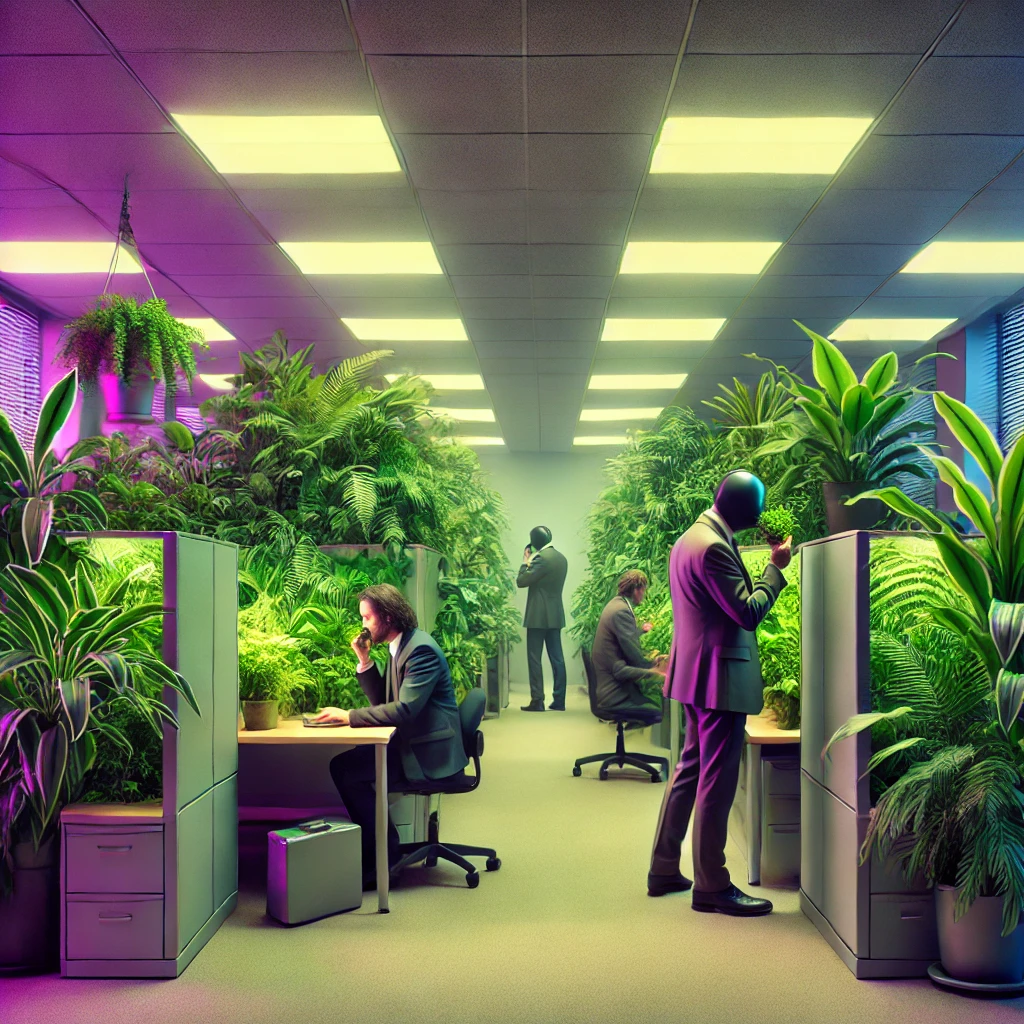The Silent Guardians of Cubicle Greenery
Have you ever noticed that office plants somehow manage to survive despite being subjected to artificial lighting, aggressive air conditioning, and general neglect? Like, they’re literally thriving in an environment designed to crush souls, let alone photosynthesis. That’s because behind every resilient rubber plant and persistent pothos lurks a secret underground network of office plant caretakers.
Picture this: Bob from accounting isn’t just pushing spreadsheets. He’s a botanical ninja, strategically rotating plants toward optimal sunlight during “bathroom breaks,” performing covert hydration missions while microwaving his sad desk lunch, and communicating with fellow plant people through an intricate language of gentle leaf touches and knowing nods.
And dude, he’s not alone.
The Unspoken Plant Rescue Protocol
Every office has its secret plant guardians operating with military-like precision. When Susan notices the snake plant in marketing looking droopier than the team’s morale after budget cuts, a complex communication chain activates faster than you can say “photosynthesis.”
“Did you see the Sansevieria by Kyle’s desk?” she’ll casually mention at the coffee machine, code for “Code Green in Marketing, immediate intervention required.”
And here’s where it gets interesting: These plant caretakers form an unofficial union that transcends departmental boundaries and office politics. The guy from IT who never makes eye contact during meetings? He’s got a whole greenhouse at home and carries plant food in his messenger bag. The intimidating VP who everyone’s afraid to talk to? She’s propagating spider plants in her office bathroom and distributing the babies like a proud plant parent.
They share propagation tips in hushed whispers by the water cooler, exchange rare succulent cuttings like precious contraband, and collectively mourn plants lost to aggressive air conditioning or the dreaded “I thought someone else was watering it” syndrome.
Botanical Resistance: Survival Strategies of the Secret Underground Network
But why do they do it? It’s more than just keeping a plant alive. For members of this secret underground network of office plant caretakers, it’s resistance against corporate sterility. Each thriving pothos is a small rebellion against fluorescent-lit monotony, a green middle finger to soul-crushing cubicle existence.
“My fiddle leaf fig survived three reorganizations and two CEOs,” whispers Janice from HR, stroking its glossy leaves with something resembling maternal pride. “We’ve been through a lot together.”
The plant network operates on a fascinating framework: collective knowledge, shared resources, and an almost spiritual commitment to green survival. They understand something profound that the rest of the office doesn’t: plants are more than decor. They’re living connections to something bigger than quarterly reports and performance reviews.
They’re reminders that growth happens even in the most hostile environments.
The Whoa Moment: Interconnected Green Intelligence
Here’s where it gets wild. These office plant caretakers aren’t just maintaining greenery—they’re participating in a complex, living network. Plants communicate through root systems and chemical signals. By caring for them, these office heroes are actually participating in an intricate, almost sentient communication web.
(Parenthetical brain explosion: What if plants are secretly running the entire office? Like, what if that monstera in the conference room is actually making all the executive decisions while humans just carry out its leafy bidding?)
Think about it: plants have been around for millions of years, evolving complex systems of survival and communication. Humans have been doing corporate PowerPoints for, what, like 40 years? Who’s really the more advanced species here?
The secret underground network knows. They feel it when they water their green charges. There’s a connection happening that transcends the mundane. Each plant caretaker becomes part of a living system that operates beneath the surface of daily office life, a parallel universe of growth and nurturing that exists alongside spreadsheets and status meetings.
Practical Plant Preservation Tips from the Underground
For those looking to join the secret underground network of office plant caretakers, veterans offer these tried-and-true strategies:
- Always have a backup water bottle dedicated solely to plant hydration
- Know your office’s microclimates (the window by accounting gets afternoon sun; the hallway near the bathrooms has surprising humidity)
- Build alliances with janitorial staff who control temperature settings and have access after hours
- Develop a poker face for when someone asks, “Has this plant always been here?” after you’ve secretly introduced a new green friend
- Never underestimate the power of compassionate plant talk (they respond to encouragement, scientific fact)
Conclusion: The Green Revolution Starts at Your Desk
Next time you walk past an apparently thriving office plant, remember: behind its seemingly passive existence lies an entire underground network of dedicated caretakers. They’re not just maintaining plants; they’re preserving hope, one leaf at a time.
They’re creating ecosystems of care in environments designed for efficiency.
They’re proving that life finds a way, even under fluorescent lights and next to malfunctioning printers.
And maybe, just maybe, they’re onto something bigger than all of us. Because in a world of artificial intelligence, quarterly targets, and digital everything, connecting with something that grows simply because it’s alive might be the most revolutionary act of all.
Stay green, stay curious. 🌱
